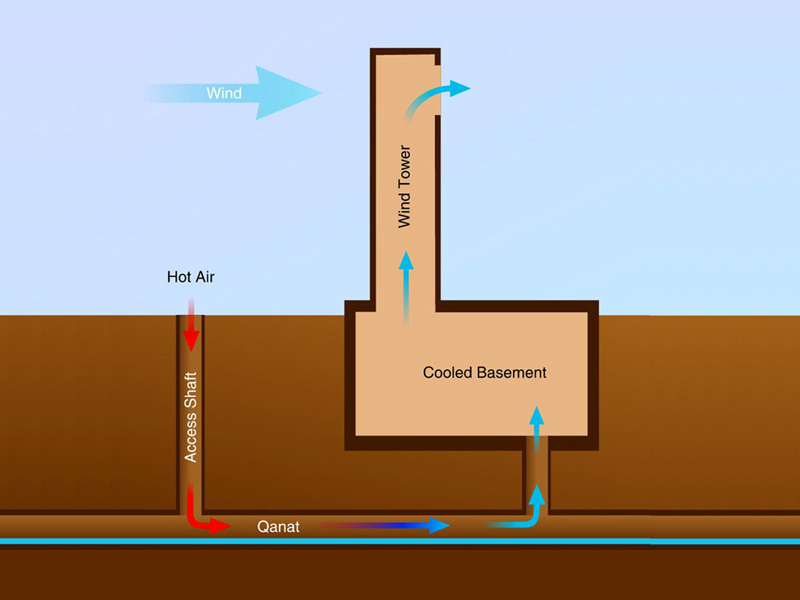Evaporative cooling, also called adiabatic cooling, is a technology that allows to cool down a closed environment in a specific structure by introducing air that is fresh and always new.
This is done through a simple physical principle known since antiquity that was already used by the Greek, Arab and Egyptian civilizations who used water as cooling element.
The water evaporation reduces the temperature of the surrounding environment, generating, in fact, an exchange of energy with the air.
Adiabatic evaporative cooling: how it works
Evaporative cooling represents the most efficient cooling system currently available for environments air-conditioning.
Today it takes advantages of advanced technological systems, known as evaporative coolers or air coolers.
Its working principle is the same used by the human body when, through sweat, it evaporates moisture ensuring the cooling of the skin.
The evaporative cooling adds to the air a quantity of water vapor that makes its humidity level close to 100% (ie close to saturation).
The air absorbs the water vapor thanks to its heat, which causes, in fact, the water evaporation.
In this way, the air increases its relative humidity percentage (the percentage ratio between the amount of vapor contained in a mass of air, and the maximum quantity that it can contain under the same conditions of temperature and pressure), losing at the same time a part of its heat with subsequent temperature lowering.
In practice, the cooling process takes place thanks to the passage of air in waterlogged filter panels; the hot air coming from outside, when passing through them produces a partial water evaporation, thus re-introduced in the cooler and cleaner environment: this phenomenon is called “sea breeze effect“.
Application fields of evaporative cooling
This evaporative system, which is defined as adiabatic, does not use any compressor or refrigerant gas, it can be easily used in different application fields (agricultural, livestock, industrial and even civil) and it is now the most “green” solution for environments air-conditioning.
Evaporative cooling is the ideal solution to reduce the temperature inside medium or large places, where it is not possible to close the doors or windows.
For example, industrial sheds, which often have large rooms and they require large amounts of energy. Its installation and energy costs would be higher than those allowed by this system.
Other examples of application fields are workshops or factories and all those places where traditional gas conditioners are a waste of energy due to the presence of air currents: theaters, churches, conference rooms and other public places.
Direct and indirect evaporative cooling
The evaporative cooling provides 3 possibilities of use: direct evaporative cooling, indirect evaporative cooling and chiller/dry cooler.
Let’s see in detail the first ones.
Direct evaporative cooling
Well-known also as DEC, it considers that air is introduced directly into the environment after passing through the evaporator, which cools and humidifies it. This is a particularly effective system when the outside air is hot and dry or in the presence of heaters.
The main benefit is represented by the low cost of management, while the disadvantage is a reduction in comfort conditions, where there is a significant amount of latent heat.
Indirect evaporative cooling
Well-known also as IEC, it considers that the air that enters in the evaporator subtracts the heat from an exchanger: this cools down the air, which therefore is not humidified.
The peculiarity of this system is that the two air are separated and therefore the air purity is preserved.
This solution is particularly indicated when the external humidity is already high.
The benefit of this system is represented by the low operating cost and, by not releasing water vapor in the cooled environment, it does not require any humidity control.
The main advantages of evaporative cooling
• Minimum environmental impact: only water is used and no substances that could be harmful to the ecosystem (CFC, HCFC, HFC that deplete the ozone layer of the atmosphere);
• Low purchase costs;
• Very low operating costs: 10% compared to common cooling methods;
• Easy installation and maintenance: for the installation of coolers, no licenses or authorizations are required and the only maintenance required is the annual cleaning of the evaporative panel and the water tank. Mobile installation is also possible thanks to the wheel kit;
• Ventilation: continuous air exchanges (or recyclables) allow to keep a healthy and controlled environment suitable for any production in the building;
• Increased productivity: climate well-being inevitably means increased productivity;
• Decreased risk of illness at work;
• Energy saving, due to the fact that evaporation eliminates a lot of heat and the airflow used is lower than the one required by the conventional heat exchange systems
PERIcooler
Termotecnica Pericoli, always paying much attention to such issues, offers its PERIcooler on the market: the efficient and effective fresh air machine able to beat the heat, significantly cutting running costs.
PERIcooler uses PERIcool pads, a technology entirely produced in Italy: thanks to the latest changes made in the production process, PERIcool is even more technological and high-performing.
Two green and highly efficient products combined together to become the optimal solution to beat the excessive heat problem.
To know more
Find out more about Termotecnica Pericoli products dedicated to cooling by clicking here.
